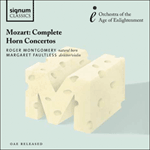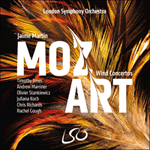
Welcome to Hyperion Records, a British classical label devoted to presenting high-quality recordings of music of all styles and from all periods from the twelfth century to the twenty-first.
Hyperion offers both CDs, and downloads in a number of formats. The site is also available in several languages.
Please use the dropdown buttons to set your preferred options, or use the checkbox to accept the defaults.


Mozart’s move from his native Salzburg to Vienna in 1781 brought a period of enormous growth and fulfilment for him, impelled by the city’s highly stimulating musical and intellectual atmosphere. Among his friends there was the horn player Joseph Leutgeb, a virtuoso of the relatively new ‘hand-stopping’ technique that had greatly extended the range of notes available on the 18th-century horn, whose performances drew praise for their ability to ‘sing an adagio as perfectly as the most mellow, interesting and accurate voice’, and who ended up the lucky recipient of no fewer than four beautifully made concertos. (The natural horn used throughout the 18th century consisted of a mouthpiece, a coiled length of tubing and a large flared bell, and was a precursor to the valved horn, which emerged in the 19th century. With no valves to alter the length of the tubing, horn players of the 18th century developed the ‘hand-stopping’ technique (moving the right hand in and out of the horn’s bell) to alter the pitch, enabling the player to reach notes beyond the instrument's natural capabilities.)
In fact, Mozart had already known Leutgeb in Salzburg, where both men had been members of the Archbishop’s court orchestra. Leutgeb had left for Vienna in 1777, however, there to combine his musical occupation with the profession of cheese and sausage-monger, and so it must have been with some pleasure (and perhaps amusement) that Mozart was reunited with him there. The fact that the manuscript of the first concerto he wrote for him in 1783 bears an inscription claiming that the composer had ‘taken pity on Leutgeb, ass, ox and fool’, and that the fourth carries even more ribald remarks at the soloist’s expense, suggests that friendship was established on fairly robust lines.
The Horn Concerto known as Mozart’s second was actually his first for the ‘ass, ox and fool’, and was completed on 27 May 1783. Despite the insults, Mozart evidently had faith in Leutgeb’s skills, although comparison with horn parts written for other players suggests that he took trouble to accommodate greater comfort in the higher register. The music’s character, too, is dignified and charming, particularly in the poetic lines of the central slow movement, which exploit Leutgeb’s famous lyrical skills. It is also true, however, of the majestic first movement and the finale, whose cantering rhythms evoke the horn’s customary associations with the post-horn.
from notes by Lindsay Kemp © 2021
En quittant Salzbourg, sa ville natale, pour s’installer à Vienne, en 1781, Mozart allait connaître une période de croissance et d’épanouissement considérables, favorisée par l’atmosphère musicale et intellectuelle très stimulante de la ville. Parmi ses amis, figurait le corniste Joseph Leutgeb, un virtuose rôdé à la technique relativement nouvelle du «hand-stopping», qui avait considérablement élargi la gamme de notes disponibles sur le cor du XVIIIe siècle, et dont les performances étaient louées pour leur aptitude à «chanter un adagio aussi parfaitement que la voix la plus douce, la plus intéressante et la plus juste», lequel corniste a fini par être l’heureux bénéficiaire de pas moins de quatre concertos magnifiquement réalisés. (Le cor naturel utilisé au XVIIIe siècle se composait d’une embouchure, d’un tube enroulé et d’un grand pavillon évasé, et est l’ancêtre du cor à pistons, apparu au XIXe siècle. En l’absence de pistons pour modifier la longueur du tube, les cornistes du XVIIIe siècle développèrent la technique du «hand-stopping» (mouvement de la main droite vers l’intérieur et l’extérieur du pavillon du cor) pour modifier la hauteur de la note.)
En fait, Mozart avait déjà eu l’occasion de connaître Leutgeb à Salzbourg, où les deux hommes avaient été membres de l’orchestre de la cour du prince-archevêque. Mais Leutgeb était parti pour Vienne en 1777, afin de combiner son activité musicale avec la profession de marchand de fromage et de saucisses, et c’est donc avec un certain plaisir (et peut-être un certain amusement) que Mozart l’y rejoignit. Le fait que le manuscrit du premier concerto qu’il écrivit pour lui, en 1783, porte une inscription affirmant que le compositeur avait «pris en pitié Leutgeb, cet âne, ce boeuf et cet imbécile», et que celui du quatrième contient des remarques encore plus cinglantes à l’égard du soliste, laisse penser que leur amitié avait quand même dû s’établir sur des bases assez solides.
Le Concerto pour cor connu pour être le deuxième composé par Mozart pour l’instrument, allait être en fait le premier à être écrit pour «l’âne, le boeuf et l’imbécile», et fut achevé le 27 mai 1783. Au-delà des railleries, Mozart avait manifestement confiance dans les compétences de Leutgeb, bien que la comparaison avec certaines parties de cor écrites pour d’autres musiciens suggère que notre compositeur se donna la peine de s’adapter, afin de permettre un plus grand confort à l’instrumentiste, dans le registre supérieur. Le caractère de la musique est également empreint de dignité et de charme, en particulier dans les lignes poétiques du mouvement lent central, destinées à mettre en valeur les talents lyriques bien connus de Leutgeb. Mais c’est également le cas du majestueux premier mouvement et du Finale, dont les rythmes endiablés légitiment les associations qu’on a coutume de faire entre le cor proprement dit et le cor de postillon.
extrait des notes rédigées par Lindsay Kemp © 2021
Français: Pascal Bergerault
Mit Mozarts Übersiedlung 1781 aus seiner Heimatstadt Salzburg nach Wien begann für ihn eine Phase immensen Wachstums und großer Erfüllung, bedingt durch die überaus anregende musikalische und intellektuelle Atmosphäre der Stadt. Zu seinem dortigen Freundeskreis gehörte der Hornist Joseph Leutgeb (auch „Leitgeb“), der die relativ neue Technik des „Stopfens“ virtuos beherrschte; mit ihr konnte die Bandbreite der Töne auf dem Horn des 18. Jahrhunderts stark erweitert werden. Leutgeb wurde gepriesen wegen seiner Fähigkeit, mit dem Horn „ein Adagio so perfekt wie die lieblichste, interessanteste und präziseste Menschenstimme zu singen“, und er wurde mit sage und schreibe vier wunderschön gestalteten Konzerten beschenkt. (Das im 18. Jahrhundert gängige Naturhorn bestand aus einem Mundstück, einer gebogenen Metallröhre und einem weiten Schalltrichter; es war ein Vorläufer des Ventilhorns, das im 19. Jahrhundert aufkam. Wegen der fehlenden Ventile, die die Länge der Röhre verändern, entwickelten die Hornisten des 18. Jahrhunderts die Technik des „Stopfens“ (sie steckten die rechte Hand mehr oder weniger tief in den Schalltrichter), um die Tonhöhe zu verändern, wodurch sie Noten jenseits der natürlichen Töne des Instruments erzeugen konnten.)
Die Bekanntschaft Mozarts mit Leutgeb hatte bereits in Salzburg begonnen, wo beide der Kapelle des Fürsterzbischofs angehörten. Allerdings war Leutgeb schon 1777 nach Wien gegangen, um seine musikalische Tätigkeit mit dem Käse- und Wursthandel zu verbinden, und so muss es Mozart doch eine gewisse Freude (vielleicht gepaart mit Belustigung) bereitet haben, ihn dort wiederzusehen. Dass das Manuskript des ersten Konzerts, das er 1783 für ihn komponierte, mit der Bemerkung versehen ist, der Komponist habe „sich über den Leitgeb Esel, Ochs und Narr erbarmt zu Wien“, lässt darauf schließen, dass ihre Freundschaft auf recht derben Fundamenten ruhte.
Das Hornkonzert, das als Mozarts zweites bekannt ist, war sein erstes für den „Esel, Ochs und Narr“ und wurde am 27. Mai 1783 fertiggestellt. Trotz der Beleidigungen vertraute Mozart eindeutig Leutgebs Fähigkeiten, obwohl ein Vergleich mit Stimmen für andere Hornisten nahelegt, dass der Komponist sich in den höheren Tonlagen um leichtere Spielbarkeit bemühte. Auch ist das Wesen der Musik würdevoll und charmant, insbesondere in den lyrischen Linien des mittleren langsamen Satzes, die die berühmten lyrischen Fähigkeiten Leutgebs zur Geltung bringen. Das gilt allerdings ebenso für den majestätischen ersten Satz und das Finale, in dessen galoppierendem Rhythmus die traditionelle Verbindung des Horns mit dem Posthorn anklingt.
aus dem Begleittext von Lindsay Kemp © 2021
Deutsch: Ursula Wulfekamp
 Mozart: Horn Concertos Mozart: Horn ConcertosUnder the direction of Margaret Faultless the OAE shines on these new recordings of Mozart’s Horn Concertos, featuring sublime performances by Roger Montgomery on the natural horn.» More |
 Mozart: Wind Concertos Mozart: Wind ConcertosPrincipal players of the London Symphony Orchestra display their virtuosic talents on this album of concertos for wind instruments by Mozart, recorded in concert in the excellent acoustic of the Jerwood Hall at LSO St Luke’s.» More |

